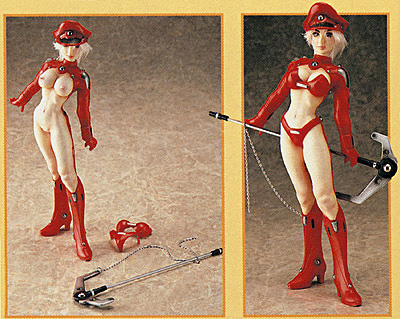| Umělec magazine 2000/1 >> Toys, Boys, Girls | List of all editions. | ||||||||||||
|
|||||||||||||
Toys, Boys, GirlsUmělec magazine 2000/101.01.2000 Tomodachi no Uranchan (Přátelé Uranové dívky) | japan | en cs |
|||||||||||||
|
"The uniform all Japanese children must wear from the very beginning of his or her studies is not only comprised of a mere “jersey” worn to school, but also of a sweat suit and bag—everything. No individuality is allowed, not even in hairstyles and, in the case of girls, earings. The slightest deviation is squashed, and when a student steps out of line, a meeting is called to carefully explain the rules. Even the elite kindergardens demand kids to be dressed in uniforms, complete with a color code and design specially made for their particular elementary or highschool. And even their hair-dos eventually conform to the uniform.
In larger cities, you may spot a number of young girls in the bathrooms of luxurious department stores, adjusting the chaste length of their skirts, rolling them up and tucking them into the waistline so that the skirts just cover their bottoms. The fat rolls thus envisaged are hidden under a designer sweater and the uniform’s jacket. This is perhaps the first irreconcilable individualization they experience. TV programs for teenagers flaunt sexless pop stars, mostly men wearing theatrical make-up, skirts and feminine hairdos. They naturally become the youngest generation’s pathetic pop-idols. For a European, their look is completely foreign; perhaps it’s similar to Kabuki, traditional Japanese theater. Despite the fact that even today tradition is quite clearly visible, it would have to be analysed directly by a Japanese person, as it is nearly impossible for a foreigner. The uniforms are both frustrating and one of the hottest themes for contemporary Japanese pornography. Bookstores sell magazines specializing in schoolgirl porn featuring uniforms. Boys, on the other hand, develop a highly sophisticated style, transforming their uniforms and proper hairdos into “bad-boy” style in just two minutes, again somewhere in the bathrooms. Their adjustments, however, are implemented within the limitations of the uniforms: they ingeniously flip the wristband and collars. They don’t especially mind the uniforms, considering it a petty rule they have to follow. So they simply don’t try to deal with it. All they need is a little subtle flash within the regulations. Those who have a real problem with this, exhibitionistic inclinations or affection for models, go to Harajuku, a part of Tokyo where all the monstrously dressed martians wander through second hand shops and dark little corners full of spangles and accessories. It is a far more interesting show than pathetic TV programs with completely free people in an otherwise uptight life style. They act very naturally, as if this multi-layered, colorful style were pulsing rhythmically in their veins. It is interesting that traditional kimonos use mostly gray, natural patterns. Japanese women with traditional taste would never wear any bright colors. To them the color of rice in any season is the most beautiful. It is a question of taste; symbiosis with nature is, of course, beautiful, but there are bright pink bushes and violet irises growing in the rice fields for those off their leashes. "
01.01.2000
Recommended articles
|
|||||||||||||















Comments
There are currently no comments.Add new comment